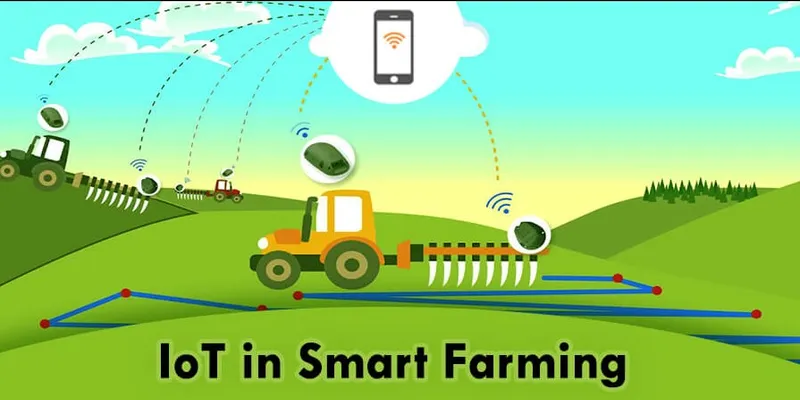

Revolution in farming – IoT based smart farming
Let's see how IoT helps farmers to do smart work and get more productive results.
The world population is expanding at a fantastic rate is believed to cross 9.6 billion by the year 2050. While the population is increasing at such a scorching rate, the amount of land under cultivation has remained the same and so it will be in 2050 also.
If humanity needs to survive, it has to squeeze the maximum out of the available land under cultivation. To help us to get out of this predicament is science and our advancement in allied technologies.

Smart Farming with IoT
The advancement in our scientific knowledge and rapid progress made in wireless and AI technologies has made it possible for us to improve our agricultural yields significantly.
Among a range of technologies that you can call upon to improve your per acre agriculture product yield, the one that is showing the maximum promise is the IoT(Internet of Things).
IoT is actually an enabling technology that allows you to control various equipment and sensors wirelessly. This is immensely helpful to not only reduce the cost of hiring additional manpower but also to limit the harmful impact on the environment. It also helps us to use the resources in a more sustainable manner.
If you want to use the IoT to improve your profit margin in farming, then besides the use of sensors, equipment, you also have to invest in dedicated app development process.
There are many companies out there which can build the application of your choice to control all your equipment through your smartphone or computer.
Many companies in the market that are working on iOS or Android app development can build you custom apps that will provide you with the best solution for all your issues relating to synchronizing various sensors, equipment, and drones that can be used in agriculture.
The amazing fact of the IoT is that it can be applied in any form of agriculture; large scale, small-scale or kitchen gardens, organic farming and greenhouse-based farming among others.
Here we will like to discuss the scope of this technology and how it will help any farmer who will like to adopt these new age machines to improve his agricultural production.
Precision farming
As the name suggests, this type of farming does not rely on the traditional extensive farming strategies but is more concerned with using the resources optimally for better production targets and reducing wastages.
You can ask experts in Android app development to build you an app that will help you to check different aspects of the agricultural process through a host of sensors placed strategically around your field.
Some of the data collection points could be helpful in:
• Checking for the moisture level in the soil and the nutrients present there
• Monitoring the flow of water to ensure that all the plants get adequate water and there is no wastage of this precious resource
• Checking on the soil health to determine what kind of fertilizer and in what quantity you need to use
• Checking the best time to harvest the crops
• Looking at the weather patterns to decide when to sow, irrigate and harvest so that you get the optimum crop yield with minimum wastage.
While talking about all these technologies looks like science fiction now, but in reality, there are many revolutionary new technology applications that if applied in large scale has the potential to change the face of our agriculture and how we do things there completely.
1). There are several new age high precision sensors on the market that are made to provide accurate information about the amount of soil moisture, nutrients, and temperature.
You can access this information wirelessly in real time on your synced smartphone or tab.
2). The need to monitor the temperature is not only important for the sowing and harvesting purposes but is also very useful in the storage and processing of the agricultural materials.
Regulating the temperature inside the storage silos is important to prevent any spoilage of the agricultural products stored there. In the processing stage, if the temperature is not maintained at a particular range, then there are chances that the conveyor belt may catch fire or the dust build-up can cause an explosion.
3). If you want to prevent any wastage of your stored grains and reduces the chances of accidents in the silos or conveyor belts due to temperature build up, then you can make use of a host of sensors, wireless technology to keep track of the temperature, humidity, and increased vibrations.
In case there is any abnormality in the data regarding the temperature, vibration or humidity, you can ask the company that has helped you in the app development to make sure that the computer algorithm informs you immediately so that you can take corrective decisions.
4). If you want to reduce the wastage of the seeds and plants the crops in the shape of a map, then you can do it through the IoT development.
5). Drones for improving the agriculture is the new path that scientists working to improve data collection, crop health assessment, irrigation, crop spraying and soil analysis among a host of other issues.

Precision farming
These drones with a plethora of sensors are ideal to watch over a large area and collect data for different purposes. And as these drones can be wirelessly controlled, they give you the ability to observe and in case of need intervene to improve the crop yield and reduce any damage it might face due to pests or weeds.
6). As the IoT technology can be used on large scale farming, it can also be used in a small scale greenhouse farming.
When you use IoT in greenhouse farming, then you are able to change the temperature inside the Greenhouse so that it stays in the optimum range of the crop that you have planted there. And in case there is a slight variation, then you can wirelessly change it back without manual intervention.
As you see IoT is the future of agriculture and it will allow a farmer to take care and manage all the major functions of his land holding a smartphone or his laptop.







